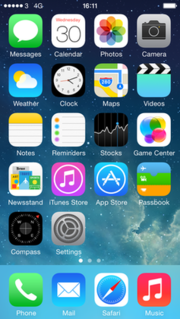
Loopt was a company based in Mountain View, California, United States which provided a service for smartphone users to share their location selectively with other people. The service supported iPhone, BlackBerry, Android and Windows Phones. Loopt's services had more than five million registered users and partnerships with every major U.S. mobile phone carrier. Their applications offered a variety of privacy controls. In addition to its core features, users also had the ability to integrate Loopt with other social networks, including Facebook and Twitter.
A mobile operating system is an operating system for mobile phones, tablets, smartwatches, 2-in-1 PCs, smart speakers, or other mobile devices. While computers such as typical laptops are 'mobile', the operating systems used on them are generally not considered mobile ones, as they were originally designed for desktop computers that historically did not have or need specific mobile features. This distinction is becoming blurred in some newer operating systems that are hybrids made for both uses.

iOS is a mobile operating system created and developed by Apple Inc. exclusively for its hardware. It is the operating system that powers many of the company's mobile devices, including the iPhone and iPod Touch; the term also included the versions running on iPads until the name iPadOS was introduced with version 13 in 2019. It is the world's second-most widely installed mobile operating system, after Android. It is the basis for three other operating systems made by Apple: iPadOS, tvOS, and watchOS. It is proprietary software, although some parts of it are open source under the Apple Public Source License and other licenses.

Shazam is an application that can identify music, movies, advertising, and television shows, based on a short sample played and using the microphone on the device. It was created by London-based Shazam Entertainment, and has been owned by Apple Inc. since 2018. The software is available for Android, macOS, iOS, Wear OS, watchOS and as a Google Chrome-extension.
On Apple devices running iOS and iPadOS-based operating systems, jailbreaking is a privilege escalation exploit executed to remove software restrictions imposed by the manufacturer. Typically it is done through a series of kernel patches. A jailbroken device permits root access within the operating system and provides the right to install software not available through the App Store. Different devices and versions are exploited with a variety of tools. Apple views jailbreaking as a violation of the end-user license agreement, and strongly cautions device owners not to try to achieve root access through the exploitation of vulnerabilities.

Cydia is a graphical user interface of APT for iOS. It enables a user to find and install software not authorized by Apple on jailbroken iPhones, iPads and iPod touch devices. It also refers to digital distribution platform for software on iOS accessed through Cydia software. Most of the software packages available through Cydia are free of charge, although some require purchasing.

Find My iPhone was an app and service provided by Apple Inc. that allowed remote of iOS devices, Mac computers, Apple Watch, and AirPods. Both Find My iPhone and Find My Friends were combined into the app Find My in iOS 13 and iPadOS 13 in 2019.

Apple Books is an e-book reading and store application by Apple Inc. for its iOS and macOS operating systems and devices. It was announced, under the name iBooks, in conjunction with the iPad on January 27, 2010, and was released for the iPhone and iPod Touch in mid-2010, as part of the iOS 4 update. Initially, iBooks was not pre-loaded onto iOS devices, but users could install it free of charge from the iTunes App Store. With the release of iOS 8, it became an integrated app. On June 10, 2013, at the Apple Worldwide Developers Conference, Craig Federighi announced that iBooks would also be provided with OS X Mavericks in fall 2013.

Bump! is a discontinued iOS and Android mobile app that enables smartphone users to transfer contact information, photos and files between devices. In 2011, it was #8 on Apple's list of all-time most popular free iPhone apps, and by February 2013 it had been downloaded 125 million times. Its developer, Bump Technologies, shut down the service and discontinued the app on January 31, 2014, after being acquired by Google for Google Photos and Android Camera.
Flipboard is a news aggregator and social network aggregation company based in Palo Alto, California, with offices in New York, Vancouver and Bejiing. Its software, also known as Flipboard, was first released in July 2010. It aggregates content from social media, news feeds, photo sharing sites and other websites, presents it in magazine format, and allows users to "flip" through the articles, images and videos being shared. Readers can also save stories into Flipboard magazines. As of March 2016 the company claims there have been 28 million magazines created by users on Flipboard. The service can be accessed via web browser, or by a Flipboard application for Microsoft Windows and macOS, and via mobile apps for iOS and Android. The client software is available at no charge and is localized in 21 languages.

iMessage is an instant messaging service developed by Apple Inc. and launched in 2011. iMessage functions exclusively on Apple platforms: macOS, iOS, iPadOS, and watchOS.
A mobile application or app is a computer program or software application designed to run on a mobile device such as a phone, tablet, or watch. Mobile applications often stand in contrast to desktop applications which are designed to run on desktop computers, and web applications which run in mobile web browsers rather than directly on the mobile device.
Flud was a social news reader application for iPad, iPhone, Android and Windows Phone. It was designed to display RSS feeds from blogs and news sites into individual streams for easy viewing. In Flud, articles and stories could be stored for later reading with the Reading List, shared as a favorite read with the Flud button, and shared with Facebook, Twitter, email, Tumblr, Instapaper, and ReadItLater. Flud was headquartered in the historic Spreckels Theater Building in San Diego, California, with remote offices in Detroit and Chicago.

Feedly is a news aggregator application for various web browsers and mobile devices running iOS and Android. It is also available as a cloud-based service. It compiles news feeds from a variety of online sources for the user to customize and share with others. Feedly was first released by DevHD in 2008.

News360 is a personalized news aggregation app for smartphones, tablets and the web. It attempts to learn a user's interests by analyzing their interaction with news stories on the app and using semantic analysis and natural language processing to create an Interest Graph and construct a unique feed of relevant content for each user. The app claims an audience of more than 4 million users.

iOS 7 is the seventh major release of the iOS mobile operating system developed by Apple Inc., being the successor to iOS 6. It was announced at the company's Worldwide Developers Conference on June 10, 2013, and was released on September 18 of that year. It was succeeded by iOS 8 on September 17, 2014.

Snapseed is a photo-editing application for iOS and Android that enables users to enhance photos and apply digital filters. It was created by Nik Software, and is now owned by Google.

Apple News is a news aggregator app developed by Apple Inc., for its iOS, iPadOS, watchOS, and macOS operating systems. The iOS version was launched with the release of iOS 9. It is the successor to the Newsstand app included in previous versions of iOS. Users can read news articles with it, based on publishers, websites and topics they select, such as technology or politics.

Pre-installed iOS apps, referred to in the App Store as 'Built-In Apps', are a suite of mobile applications developed by Apple Inc. which are bundled with iOS and installed by default or through a system update. Many of the default apps found on iOS have counterparts on Apple's other operating systems macOS, iPadOS, watchOS, and tvOS, which are often modified versions of or similar to the iOS application. As each app is integrated into the operating system itself, they often feature greater support for system features than third-party alternatives and are quick to adapt new features of iOS.













